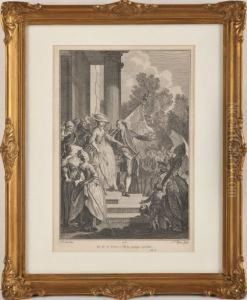Nicolas Ponce Paintings
Nicolas Ponce was a notable French engraver, draughtsman, and writer born in Paris on October 8, 1746. He was recognized for his skill in engraving, which was a highly regarded art form during the 18th century. Ponce received his training under the famous French engraver and illustrator, Jean-Michel Moreau, also known as Moreau le Jeune. Under Moreau's guidance, Ponce honed his skills and developed a keen eye for detail, which would become characteristic of his work.
Ponce's career flourished during the French Enlightenment, a period that emphasized reason, science, and the arts. His engravings covered a wide range of subjects, including scenes from classical mythology, portraits, and historical events. He became particularly known for his exactitude and the refinement of his line engravings.
During the French Revolution, Ponce's assignments reflected the changing political climate. He created images that were used in revolutionary propaganda but managed to navigate the tumultuous period without significant conflict, allowing him to continue his work into the Napoleonic era.
In addition to his engravings, Ponce was also an accomplished author and art historian. He penned several books on art and artists, contributing to the scholarship of the period. His writings reflect the Enlightenment's ideals of knowledge dissemination and the importance of the arts in society.
Nicolas Ponce's legacy is preserved through his numerous engravings that capture the spirit of his time. He passed away on December 1, 1831, leaving behind a body of work that continues to be studied and admired for its precision and beauty. His contributions to French art were significant, and he remains a respected figure in the history of engraving.
